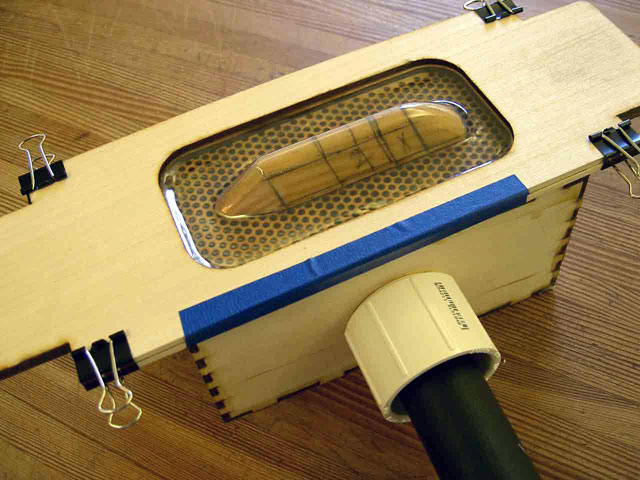|
Vac-U-Box
Vacuum
Forming Device

Nautilus Models
S u m m a r y
|
|
Catalogue Number: |
Vac-U-Box |
|
Contents and Media: |
Wooden
vacforming device |
|
Price: |
USD$27.50
available online from Nautilus Models |
| Review
Type: |
First Look |
|
Advantages: |
Inexpensive; very useful; will form up to 2 ½
x 6 ½ inches |
|
Disadvantages: |
Needs
separate heat source |
|
Recommendation: |
Recommended |
Reviewed by Frank
Mitchell

HyperScale is proudly
supported by Squadron.com
As many know, I am on a
perpetual crusade to get modelers to expand their horizons
and prove to themselves that they can do major conversions
and scratchbuilts. Thus, I am breaking my normal rule of no
endorsements to mention this cool little tool called a Vac-u-Box.
It costs $27.50, and can use any vacuum cleaner that has a
hose.
The machine is made of wood,
and incorporates high-tech ¾" paper clamps to hold the
plastic. It comes assembled and painted (the photos are of
the unpainted prototype). All that needs to be done is to
find a means of heating the plastic. I have tried my wife's
oven, a heat gun, and even the stove top (remembering that
the box is wooden), and all work fine (after a bit of
practice). Also, because of the relatively small size, the
power of the vacuum is plenty to do anything that will fit
within the practical working area of roughly 2 ½ x 6 ½
inch opening in the handles, meaning you will need to use a
piece of styrene or clear vinyl of about 4 x 10 inches. I
have tried a number of subjects, including a full canopy for
a 32 nd Dauntless with no problems.
It will handle any thickness of
styrene or vinyl, but anything over .030 really requires a
lot of heat and probably is not practical for a wooden box.
It is available through
Nautilus Models, which can be reached at:
http://nautilusmodels.com/
Highly Recommended
The following hints and tips on
how to use the Vac-U-Box have been reproduced from the
tool's instructions:
Vacuum-forming is something that requires some experience
to do properly every time, but it is quickly learned. You
will rapidly learn how much “sag” you need for any given
combination of material and subject. Further, if the object
does not mold properly, the plastic can be simply be
re-heated and used again.
The Vac-U-Box can use any thickness of material, but
anything over .030 requires a considerably longer heating
time and could therefore cause the wooden frame to warp.
Clear material (which is usually vinyl) needs less
temperature than does styrene, therefore, it is ready to
mold with less heating.
Heat sources can include an normal oven, a heat gun (but be
careful to heat the sheet evenly), or even a stovetop, but
be very careful of the fingers, be sure to wear gloves, and
remember that the Vac-U-Box is wooden.
Virtually any vacuum cleaner that has a hose attachment can
be used.
Procedure:
-
Tape the two parts of the
holder together along one edge.
-
Cut desired plastic into
sheets roughly 4 inches by 7 inches.
-
Using small (3/4 inch)
office supply clamps, clamps the plastic into the
holder, making sure that it overlaps the hole on all
sides.
-
Fix the object to be
molded in the center of the perforated base of the Vac-U-Box
using something tacky or simply double-folded tape.
(This maintains its center position and prevents it
being moved during molding).
-
Heat the plastic until it
begins to sag evenly in the holder.
-
Turn on vacuum cleaner.
-
Using gloves, quickly
pick up the holder and place it over the Vac-U-Box. Try
to place it as centrally as possible.
-
Turn off vacuum cleaner
and remove holder.
-
Open clamps and remove
the molded object.
The following photos illustrate the
procedure.
Click the thumbnails below to view larger images:
[../../../photogallery/photo00020360/real.htm]
Review Text Copyright © 2007 by Frank
Mitchell
Instructional Text and Images Copyright © 2007 by Vac-U-Box
Page Created 11 January, 2007
Last updated 24 December, 2007
Back to HyperScale Main Page
|
Home
| What's New |
Features |
Gallery |
Reviews |
Reference |
Forum |